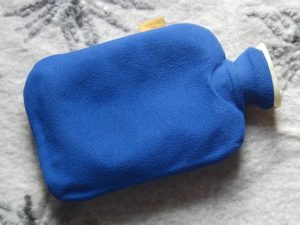I get a lot of people reaching out to me to ask about the best tips for sciatic nerve pain relief. Luckily, that’s exactly what I do! Ice and heat are really useful, totally natural pain relieving methods for a variety of injuries. Today, we are going to talk about when you should use ice and when you should use heat for sciatica pain relief.
Before we dive in, please be aware that we are part of the Amazon Affiliate programme. This page may contain Amazon affiliate links, so if you choose to purchase a product for your sciatica that we recommend through a link on this page, we will receive a small commission at no extra cost to you. This helps us keep Overcome Sciatica alive! Thank you for your support. Please be assured that we only ever recommend products that we truly believe can help.
How Does Ice Work?
First, we need to understand how each of these treatment modalities work. Let’s begin with ice.
Ice has long been thought of as nature’s natural pain killer. It has powerful effects on the human body when applied to the skin, some of which we have only recently begun to understand.
Ice has been used for many years as a form of pain relief, and there are accounts of ice being used to treat injuries in the earliest days of mankind. (Presumably, this was only possible in cold winters; luckily, nowadays we have freezers to produce this useful tool for us.)
Ice works through a couple of mechanisms:
- Ice, when applied to the skin, produces an effect called “vasoconstriction” in the blood vessels – which basically means the small vessels narrow and shut down blood flow to that area. That’s one of the reasons ice is so useful for swelling, such as after an ankle sprain.
- Ice also has an effect on the nerves around the area, dampening their signals which means we feel naturally less pain with an injury.
- Ice also encourages a flushing out of the potentially harmful chemicals around an injury site and reduces inflammation.
How Does Heat Work?
When we say heat, what we mean usually is a warm compress, hot water bottle or wheat cushion applied to an area of skin around an injury. You could also get these effects from a hot bath or shower, but this would be a less “targeted” way of treating an area.
Heat works roughly in the opposite way that ice works. It, too, has a number of effects to the body when applied around an injury:
- Heat causes an effect called “vasodilation” to the blood vessels around an area – which means a widening of the vessels, increasing blood flow to an injured site. You wouldn’t want to use heat on a recently sprained ankle (unless you wanted a HUGE amount of uncomfortable swelling!)
- Heat doesn’t affect the nerves like ice does, but it does increase healthy blood flow to an area, which can cause an increased rate of healing to some injuries (especially chronic, long-term ones). It also helps to flush away the nasties within the blood that invade an injured area.
- Heat has an effect on the surrounding muscles and joints whereby it “loosens” them up by making the tissues more “elastic” and pliable. This basically means you can increase the flexibility of an area just by heating it up. Try to stretch a muscle in the cold, then try to stretch the same muscle after a hot shower – you’ll find you can stretch way further after the hot treatment.
So, Do You Use Heat or Ice for Sciatica?
The answer to this question depends on the main problem you have, as well as the location of the pain.
The first question to ask yourself is this: Is my main problem PAIN or STIFFNESS?
The second question is: Is my main problem area my LEG or my BACK?
Let’s talk about each scenario one by one…
If you answered with PAIN in the LEG
You might want to opt for ice. If your main problem is sciatic nerve pain in the leg, I would apply the ice directly to the most painful area.
You’ll want to use a few layers between the ice and your skin. My preferred method would be:
- Take a bag of frozen peas from the freezer
- Wrap a thin towel around them
- Dampen the towel slightly, then apply to the painful area for 15 minutes
- Remove the peas/towel and let the area heat back up to its natural skin temperature
- You can then apply the peas/towel again. There is no limit to how many times you can do this.
- Always look out for any signs of ice burn on your skin and remove immediately if you see or feel anything.
If you answered with PAIN in the BACK
You might want to try alternating between heat and ice on the lower back if your main sciatica symptom is back pain.
If you applied ice alone to your lower back, you might get some effective pain relief, but I found that my clients complained of worsening stiffness when they treat their back with just ice. For this reason, I would suggest you try for the best of both worlds and get the pain relieving effects of ice AND the mobility improvements that heat bring.
The other advantage of trying both is that you will get the chance to feel which one works best for YOU. As everyone is different, it’s important to take note of how you feel after each treatment.
To use this method:
- Take a bag of frozen peas from the freezer
- Wrap a thin towel around them
- Dampen the towel slightly, then apply to the painful area for 15 minutes
- Remove the peas/towel
- Take a hot water bottle (make sure it isn’t hot enough to burn the skin)
- Apply it immediately to your lower back, where the ice was earlier
- Keep it there for 15 minutes, then remove
- Go back to the peas/ice – and repeat the process as many times as you need
- Always look out for any signs of ice or heat burn on your skin and remove immediately if you see or feel anything.
If you answered with STIFFNESS in the LEG
Although this is a rarer complaint, if stiffness in the leg was someone’s main sciatica symptom, I would opt for applying heat to the affected buttock.
This would encourage better mobility for the sciatic nerve around the hip and allow greater movement of the leg.
To use this technique, follow this method:
- Start laying on your front on a bed or mat (whichever is more comfortable). Never sit on a hot water bottle
- Take a hot water bottle (make sure it isn’t hot enough to burn the skin)
- Apply it immediately to your affected buttock
- Keep it there for 15 minutes, then remove
- Allow the skin to cool to a natural temperature, then repeat the process
- Always look out for any signs of heat burn on your skin and remove immediately if you see or feel anything.
If you answered with STIFFNESS in the BACK
Heat, heat and more heat. Honestly, the best results I’ve seen come when someone has applied (sensible!!) heat to the back to allow better movement and less of that horrible rod-up-your-back sensation.
For best effects, use this method:
- Start sitting up in a chair
- Take a hot water bottle (make sure it isn’t hot enough to burn the skin)
- Slip it behind your back and apply it to the stiffest area
- Keep it there for 15 minutes, then remove
- Allow the skin to cool to a natural temperature, then repeat the process
- Always look out for any signs of heat burn on your skin and remove immediately if you see or feel anything.
Summary
Ice and heat are both phenomenal tools that are easily applied to help recovery from an injury. Although there can be confusion about when to use ice and when to use heat, use the handy guide above for best results. At the end of the day, a lot of it will come down to personal preference, so if you aren’t getting the desired effect with ice, try heat and vice versa.
Do you find ice or heat to work better? Let me know in the comments below!
Are You Looking for RAPID Relief from Sciatica?
My good friend, colleague and fellow international sciatica expert, Dean Volk, has a brand new sciatica relief video course available – and I’m delighted to be an official sponsor!
Check out Dean Volk’s “Kicking Sciatica OUT of the Butt!” Online Pain Relief Course Here!
I can proudly recommend Dean and his course for sciatica sufferers – because I’ve seen his incredible results first-hand. You can check out his course (and get lifetime access to the videos and bonus content) by clicking HERE.
The information on Overcome Sciatica should never be used as a substitute for medical advice from a doctor. Never put into action any tips or techniques from Overcome Sciatica without checking with your doctor first. Please see full terms of use here.





